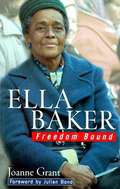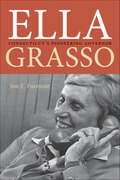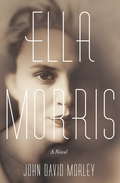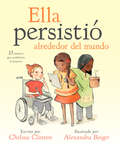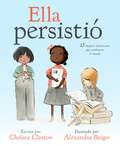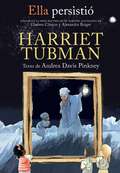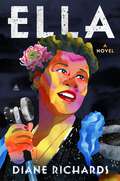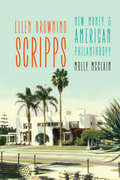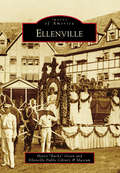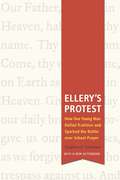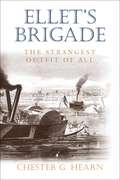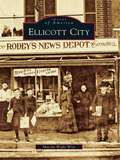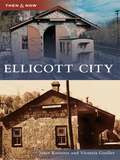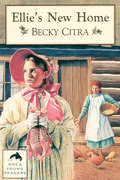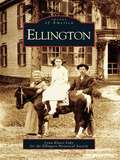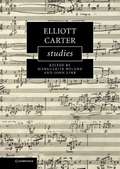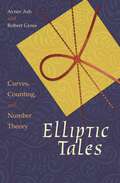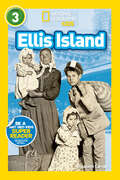- Table View
- List View
Ella Baker: Freedom Bound
by Joanne GrantThis is the story of Miss Ella Baker who once worked for Martin Luther King, Jr. She is both one of thousands of anonymous women and men who made the twentieth-century movement for expanded democracy work, and among the most extraordinary members of that group. It is time for a larger audience to meet her, and thanks to Joanne Grant, they will.
Ella Grasso: Connecticut's Pioneering Governor (The Driftless Connecticut Series)
by Jon E. PurmontWhen Ella Tambussi Grasso ran for governor of Connecticut in 1974, she had not lost an election since she was first voted into the state's General Assembly in 1952. The people of Connecticut chose her as the nation's first woman to be elected governor in her own right—the capstone of a long and successful career dedicated to public service, effective government, and the democratic process. During her tenure as governor, Grasso's leadership was tested in the face of fiscal problems, state layoffs, and budget shortfalls. The daughter of Italian immigrants, she endeared herself to her constituents during the great Blizzard of 1978, when she stayed at the State Armory around the clock to direct emergency operations and make frequent television appearances. Author Jon E. Purmont, who served as Grasso's executive assistant when she was governor, draws on his diary from that time, research in Grasso's archives, and interviews with Grasso's family and friends to give us a rich and intimate portrait of this political pioneer.
Ella Morris: A Novel
by John David MorleySpanning the decades from WWII to the Yugoslav conflict, Ella Morris is the story of a continent, and of a woman torn between two men. Born in Berlin on the eve of Hitler's rise to power, Ella Andrzejewski escapes Soviet-occupied europe and finds a safe haven in England. Here, she marries George Morris but falls passionately in love with a French student ten years her junior. The ramifications of this love triangle and of Ella's traumatic past will reverberate through the generations, as her children try to find their own troubled peace in a continent still scarred by war.
Ella Morris: A Novel
by John David MorleySpanning the decades from WWII to the Yugoslav conflict, Ella Morris is the story of a continent, and of a woman torn between two men. Born in Berlin on the eve of Hitler's rise to power, Ella Andrzejewski escapes Soviet-occupied europe and finds a safe haven in England. Here, she marries George Morris but falls passionately in love with a French student ten years her junior. The ramifications of this love triangle and of Ella's traumatic past will reverberate through the generations, as her children try to find their own troubled peace in a continent still scarred by war.
Ella persistió alrededor del mundo: 13 mujeres que cambiaron la historia
by Chelsea ClintonEn todo el mundo, las mujeres siempre han soñado en grande, aun cuando les han dicho que sus sueños no cuentan. Han alzado sus voces, se han levantado en protesta y han luchado por lo que es justo, a pesar de que, a veces, sus voces han sido silenciadas. Ya sea en las ciencias, las artes, los deportes o como activistas, mujeres y niñas a lo largo de la historia han luchado por romper barreras y cambiar el statu quo. No han permitido que otros se interpongan en su camino, nos han ayudado a entender mejor nuestro mundo y lo que es posible lograr. En este segundo libro, compañero de Ella persistió: 13 mujeres americanas que cambiaron el mundo, Chelsea Clinton presenta al lector a un grupo de trece increíbles mujeres de todo el mundo que han conformado la historia.Ella persistió alrededor del mundo es un libro para todos aquellos que han querido alcanzar las estrellas y les han dicho que no es posible, para todos los que han alzado sus voces y han sido silenciados y para todos los que, en alguna ocasión, se han sentido pequeños, insignificantes, sin importancia. Las vívidas ilustraciones de Alexandra Boiger que acompañan este inspirador texto muestran a los lectores de todas las edades que no importan los obstáculos que encuentren en su camino, pues tienen el poder de perseverar y triunfar.
Ella persistió: 13 mujeres americanas que cambiaron el mundo
by Chelsea ClintonA lo largo de la historia de Estados Unidos, siempre ha habido mujeres que han alzado sus voces para protestar por la injusticia, aun cuando tuvieron que luchar para ser escuchadas. A principio de 2017, la postura de la Senadora Elizabeth Warren, al negarse a ser silenciada durante un debate en el Senado, provocó un espontáneo homenaje a todas las mujeres que han perseverado ante la adversidad. En este libro, Chelsea Clinton rinde homenaje a trece mujeres americanas que contribuyeron a forjar los ideales de nuestro país gracias a su tenacidad, a veces alzando sus voces en señal de protesta, otras, optando por no levantarse de su asiento o cautivando al público. Todas ellas persistieron. Ella persistió es para todos los que en alguna ocasión han querido alzar su voz, pero han sido silenciados, para los que han tratado de alcanzar las estrellas, pero les han dicho que es mejor no intentarlo, y para todos aquellos a los que en algún momento los han hecho sentir insignificantes, pequeños, sin importancia. Las vívidas y persuasivas ilustraciones de Alexandra Boiger muestran a los lectores que no importan los obstáculos que encuentren en el camino, nunca deben abandonar sus sueños. Perseverancia es poder.
Ella persistió: Harriet Tubman
by Andrea Davis Pinkney Chelsea ClintonInspirado en el bestseller #1 del New York Times She Persisted de Chelsea Clinton y Alexandra Boiger, llega ahora esta serie en Chapter Books sobre mujeres que sobresalieron, lucharon y se levantaron contra viento y marea. Harriet Tubman, quien nació esclavizada, se convirtió en una de las conductoras más exitosas, más decidida y conocida del Ferrocarril Subterráneo. Con el amor de su familia firmemente plantado en su corazón, Harriet miró a la Estrella del Norte en busca de orientación para escapar, y su luz la ayudó a salir de la esclavitud. Su coraje le permitió ayudar a muchos otros a llegar también a tierra de libertad. En este chapter book biográfico de la galardonada y autora bestseller Andrea Davis Pinkney, los lectores aprenden sobre la asombrosa vida de Harriet Tubman y cómo persistió. ¡El libro se completa con una introducción de Chelsea Clinton!
Ella persistió: Sonia Sotomayor
by Chelsea ClintonInspirado en el bestseller #1 del New York Times Ella persistió / She Persisted de Chelsea Clinton y Alexandra Boiger, llega ahora esta serie en Chapter Books sobre mujeres que sobresalieron, lucharon y se levantaron contra viento y marea. Sonia Sotomayor es la primera jueza latina en la Corte Suprema en la historia de los Estados Unidos, pero su trayectoria no fue fácil. Ella tuvo que superar numerosos obstáculos y desafíos en el camino, como recibir un diagnóstico de diabetes a los siete años. Pero no dejó que eso le impidiera alcanzar su sueño e inspirar a los niños de todo el mundo a trabajar duro y tener fe en sí mismos. En este chapter book biográfico de la galardonada autora Meg Medina, los lectores aprenderán sobre la asombrosa vida de Sonia Sotomayor y cómo persistió. ¡El libro se completa con una introducción de Chelsea Clinton!
Ella's Choice: She Has Never Forgotten Him...
by Elizabeth GillFrom the bestselling author of Miss Appleby's Academy, comes the first in the Black Family trilogy. Perfect for fans of Nadine Dorries, Anna Jacobs and Catherine King. Ella's happy childhood in the Swan Island district of Durham is abruptly ended when her father dies, leaving the family bankrupt. Ella and her mother leave their home behind to go and live with her grandmother, who runs the Silver Street cafe. After a first, unhappy marriage she settles into domesticity with a local businessman, David Black. But Ella can never quite forget her first love. Now a contented wife and mother, Ella soon finds she must make an impossible choice.Note: this book was previously published under the title Swan Island.
Ella's Choice: She Has Never Forgotten Him... (The Black Family)
by Elizabeth GillFrom the bestselling author of Miss Appleby's Academy, comes the first in the Black Family trilogy. Perfect for fans of Nadine Dorries, Anna Jacobs and Catherine King. Ella's happy childhood in the Swan Island district of Durham is abruptly ended when her father dies, leaving the family bankrupt. Ella and her mother leave their home behind to go and live with her grandmother, who runs the Silver Street cafe. After a first, unhappy marriage she settles into domesticity with a local businessman, David Black. But Ella can never quite forget her first love. Now a contented wife and mother, Ella soon finds she must make an impossible choice.Note: this book was previously published under the title Swan Island.
Ella's War: A Moving and Emotional Historical Drama
by Sarah BourneA World War II nurse finds herself in a hospital bed with no memory of how she got there in this dramatic historical novel by the author of The Train.1947. Ella Elkington wakes up in hospital with minor physical injuries but no memory. She cannot even remember her own name.The doctor treating her tells her that she had a car accident and has been identified by a letter found in a handbag. Asking to see the letter, hoping to find out about herself, she learns the letter is now missing.When the hospital tracks down her brother, he visits her, and Ella has glimmers of childhood memories. After she is released from hospital, with the help of diaries and letters, and her long-time friend Sheila, Ella begins to piece together her past. She learns she was a nurse during the war, who was sent to work in a mobile hospital in France after the D-Day landings. But, haunted by nightmares, Ella struggles to understand how she ended up in the accident—as well as what happened to that letter and the man in her dreams.In order to understand who she is, Ella must face a terrible truth in order to make peace with the past and find a way to live again . . . Ella’s War is a captivating historical drama that will appeal to fans of authors like Lucinda Riley and Victoria Hislop.
Ella: A Novel
by Diane RichardsIn the vein of The Paris Wife and The Personal Librarian comes this debut novel, a magnificent work of “biographical fiction” that reimagines the turbulent and triumphant early years of Ella Fitzgerald, arguably the greatest singer of the twentieth century.When fifteen-year-old Ella Fitzgerald’s mother dies at the height of the Depression in 1932, the teenager goes to work for the mob to support herself and her family. When the law finally catches up, the “ungovernable” adolescent is incarcerated in the New York Training School for Girls in upstate New York—a wicked prison infamous for its harsh treatment of inmates, especially Black ones. Determined to be free, Ella escapes and makes her way back to Harlem, where she is forced to dance for pennies on the street.Looking for a break into show business, Ella draws straws to appear at the Apollo Theater’s Amateur Night on November 21, 1934. Rather than perform a dance routine directly after “The World Famous Edwards Sisters” number, the homeless Ella, wearing men’s galoshes a size too big, risks everything when she decides to sing Judy instead. Four years later, at barely twenty-one, Ella Fitzgerald has become the bestselling female vocalist in America.Diane Richards’ Ella Fitzgerald is inspiring and intriguing—an emotionally rich, psychologically complex character, a flawed mother and wife who struggles with deep emotional scars and trauma and battles racism, sexism, and colorism as she learns to find her voice on the stage. Ella takes us from the brothels, speakeasys, and streets of Depression-era New York City to the grand hotel suites where Ella, now older and wiser, looks back on her life and finally confronts the demons from childhood that torment her.Compelling and rich in historical detail, Ella is a remarkable debut novel about an extraordinary woman.
Ellan Vannin: After heartache, can happiness be found again?
by Lyn AndrewsAn orphaned child faces hardship, but won't give up until happiness is in her grasp... Ellan Vannin is an unforgettable saga by bestselling author Lyn Andrews that tells the story of a young woman who falls in love, despite having already loved and lost. Perfect for fans of Anne Baker, Rosie Goodwin and Maureen Lee. Life isn't easy for widowed George Vannin and his young daughter, but somehow George has raised the child alone and Ellan adores her father.Ellan is ten years old when the shaft at Foxdale Mine collapses, and her father never comes up. From then on she lives with Aunt Maud, a dour woman with a quick temper. Her husband had died in a mining accident too, and she never forgave the family at the Big House for their part in the tragedy.When Ellan is offered a chance to better herself at the Big House, Aunt Maud savagely forbids it. Ellan's chance is yet to come, but she has a long way to go before she finds the happiness she deserves... What readers are saying about Ellan Vannin: 'What a lovely story! You share Ellan's ups and downs through her life feeling like you were right there with her. Totally kept my attention although the story was light. Couldn't put it down until I had read the last page''A very moving story typical of Lyn Andrews' style. The characters seem so real, hard to believe its fiction. Full of history, poverty, lost love, kindness, and true love''This book is a must'
Elleander Morning (Fantasy Masterworks Ser.)
by Gavriel Rosenfeld Jerry YulsmanA dying woman, given a second chance to relive her life, travels back in time. Her goal: the execution of an obscure Viennese artist named Adolf Hitler. Two generations later, the assassin's granddaughter is mystified to discover a book relating the history of World War II - the chronicle of a conflict that never took place. Elleander Morning spans eight decades of the twentieth century, tracing two different timelines from two very different worlds and raising thought-provoking questions along the way. Part detective story, part thriller, and part romance, this alternative history won the 1986 Ditmar Award for best international fiction and the 1987 Kurd-Laßwitz-Preis. This edition features a new Introduction by Gavriel Rosenfeld, an expert on Nazi Germany and the Holocaust.
Ellen Browning Scripps: New Money and American Philanthropy
by Molly McClainMolly McClain tells the remarkable story of Ellen Browning Scripps (1836–1932), an American newspaperwoman, feminist, suffragist, abolitionist, and social reformer who used her fortune to support women’s education, the labor movement, and public access to science, the arts, and education. Born in London, Scripps grew up in rural poverty on the Illinois prairie. She went from rags to riches, living out that cherished American story in which people pull themselves up by their bootstraps with audacity, hard work, and luck. She and her brother E.W. Scripps built America’s largest chain of newspapers, linking Midwestern industrial cities with booming towns in the West. Less well known today than the papers started by Joseph Pulitzer and William Randolph Hearst, Scripps newspapers transformed their owners into millionaires almost overnight. By the 1920s Scripps was worth an estimated $30 million, most of which she gave away. She established the Scripps Institution of Oceanography in La Jolla, California, and appeared on the cover of Time magazine after founding Scripps College in Claremont, California. She also provided major financial support to organizations worldwide that promised to advance democratic principles and public education. In Ellen Browning Scripps McClain brings to life an extraordinary woman who played a vital role in the history of women, California, and the American West.
Ellenville
by Ellenville Public Library & Museum Henry Bucky" GreenSurrounded by the beautiful Shawangunk Mountains, Ellenville, New York, is a gateway between the Catskills, the Hudson River Valley, and New York City. Its people and places are what make Ellenville special. Artists, laborers, entrepreneurs, and national figures are among Ellenville's citizens. Its architectural gems include the Ellenville Post Office and Hunt Memorial Building, located in the heart of the village on Liberty Square; both are in the National Register of Historic Places. The original site of the Ulster County Fair, Ellenville has been home to vital American industries. The Delaware & Hudson Canal and early railways gave rise to tanneries, glassworks, a production pottery, and a knife manufactory. Resorts, boardinghouses, and inns welcomed travelers along some of the nation's oldest roads. Originating over 200 years ago as Fairchild City, Ellenville retains its small-town character to this day.
Ellery's Protest: How One Young Man Defied Tradition and Sparked the Battle over School Prayer
by Stephen D. SolomonGreat legal decisions often result from the heroic actions of average citizens. Ellery's Protest is the story of how one student's objection to mandatory school prayer and Bible reading led to one of the most controversial court cases of the twentieth century--and a decision that still reverberates in the battle over the role of religion in public life. Abington School District v. Schempp began its journey through the nation's courts in 1956, when sixteen-year-old Ellery Schempp protested his public school's compulsory prayer and Bible-reading period by reading silently from the Koran. Ejected from class for his actions, Schempp sued the school district. The Supreme Court's decision in his favor was one of the most important rulings on religious freedom in our nation's history. It prompted a conservative backlash that continues to this day, in the skirmishes over school prayer, the teaching of creationism and intelligent design, and the recitation of the Pledge of Allegiance with the phrase "under God." Author Stephen D. Solomon tells the fascinating personal and legal drama of the Schempp case: the family's struggle against the ugly reactions of neighbors, and the impassioned courtroom clashes as brilliant lawyers on both sides argued about the meaning of religious freedom. But Schempp was not the only case challenging religious exercises in the schools at the time, and Ellery's Protest describes the race to the Supreme Court among the attorneys for four such cases, including one involving the colorful atheist Madalyn Murray. Solomon also explores the political, cultural, and religious roots of the controversy. Contrary to popular belief, liberal justices did not kick God out of the public schools. Bitter conflict over school Bible reading had long divided Protestants and Catholics in the United States. Eventually, it was the American people themselves who removed most religious exercises from public education as a more religiously diverse nation chose tolerance over sectarianism. Ellery's Protest offers a vivid account of the case that embodied this change, and a reminder that conservative justices of the 1950s and 60s not only signed on to the Schempp decision, but strongly endorsed the separation of church and state.
Ellet's Brigade: The Strangest Outfit of All
by Chester G. HearnSoon after the start of the Civil War, during the naval buildup on the central Mississippi River, celebrated civil engineer Charles Ellet, Jr., formed the Ram Fleet under U.S. secretary of war Edwin M. Stanton. Perhaps the most bizarre unit organized by the Union, the rams were shunned by both the army and navy as superfluous instruments of war. However, on June 6, 1862, they proved their worth by defeating the Confederate River Defense Fleet ironclads at Memphis while the U.S. Navy simply watched. In this lively study, Chester G. Hearn details the formation and wartime exploits of Ellet's fleet, reviving the history of this fascinating but forgotten brigade.
Ellicott City
by Marsha Wight WiseEllicott City, the seat of Howard County, began its life as a mill town before the American Revolution. Quaker brothers Joseph, Andrew, and John Ellicott built their first mill in 1772. The Patapsco Valley and River provided the brothers with the fertile land and power necessary to make the finest wheat flour. Ellicotts Mills, as the town was first known, grew steadily, becoming home to mill workers and merchants. Maryland founding families such as the Carrolls, Dorseys, and Warfields kept their family fortunes in Ellicott City because of the brothers' agricultural expertise. Thus a town rich in history, tradition, and architectural gems was born. Highlighted in Images of America: Ellicott City are many long-gone local landmarks, including the Patapsco Female Institute and Rock Hill and St. Charles Colleges. Featured as well are the monuments to bygone days that have endured time, progress, floods, and fires, and are still standing today.
Ellicott City: Tales From The Patapsco River Valley (Then and Now)
by Victoria Goeller Janet KustererIn 1772, the Ellicott brothers purchased land and water rights in the valley along the banks of the Patapsco River for $3 an acre. They constructed mills, started the National Road, and brought the railroad to what was then called Ellicott's Mills.
Ellie's New Home (Orca Young Readers)
by Becky CitraEllie and her little brother Max find themselves moving from their grandmother's comfortable home in England to Upper Canada. Their mother is dead, Father wants to start over again, and in 1835 there are many opportunities for settlers in British North America. Despite the strangeness of this vast new world, Ellie is sure things will turn out all right, as long as the family stays together. But once they are in Upper Canada, Father leaves Ellie and Max with strangers on an isolated homestead, while he goes on ahead to find land and build a cabin. Although the mother and father are kind to her, Ellie makes an enemy of their daughter Mary, who is insulted by the newcomer's distant manners, fine clothes and talk of her London home. Ellie's loneliness and discomfort, however, gradually turns into a growing fear. Where is Father? Why hasn't he come back to them? A gripping story for young readers that explored the world of early settlers.
Ellington
by Ellington Historical Society Lynn Kloter FahyLocated 16 miles northeast of Hartford, Ellington was incorporated in 1786 and has retained the charm of a New England village and farming community. Originally part of Windsor, it was known as the Great Marsh. Ellington Center, with its town green and 18th- to 20th-century houses, is on the National Register of Historic Places. Japanese business pioneer Francis Hall donated the jewel of the district to his hometown in 1903--the neoclassical-revival-style library. Archival photographs preserve faded memories of schools, churches, townspeople, and a unique dentist's tooth-shaped tombstone. Ellington captures a time when John Hall's Ellington School was known worldwide, Crystal Lake was a popular summer resort, and Daniel Hallady invented the modern windmill.
Elliott Carter Studies
by Marguerite Boland John LinkOver the course of an astonishingly long career, Elliott Carter has engaged with many musical developments of the twentieth and now twenty-first centuries – from his early neo-classic music of the interwar period, to his modernist works of conflict and opposition in the 1960s and 1970s, to the reshaping of a modernist aesthetic in his latest compositions. Elliott Carter Studies throws new light on these many facets of Carter's extensive musical oeuvre. This collection of essays presents historic, philosophic, philological and theoretical points of departure for in-depth investigations of individual compositions, stylistic periods in Carter's output and his contributions to a variety of genres, including vocal music, the string quartet and the concerto. The first multi-authored book to appear on Carter's music, it brings together new research from a distinguished team of leading international Carter scholars, providing the reader with a wide range of perspectives on an extraordinary musical life.
Elliptic Tales: Curves, Counting, and Number Theory
by Robert Gross Avner AshA look at one of the most exciting unsolved problems in mathematics todayElliptic Tales describes the latest developments in number theory by looking at one of the most exciting unsolved problems in contemporary mathematics—the Birch and Swinnerton-Dyer Conjecture. In this book, Avner Ash and Robert Gross guide readers through the mathematics they need to understand this captivating problem.The key to the conjecture lies in elliptic curves, which may appear simple, but arise from some very deep—and often very mystifying—mathematical ideas. Using only basic algebra and calculus while presenting numerous eye-opening examples, Ash and Gross make these ideas accessible to general readers, and, in the process, venture to the very frontiers of modern mathematics.
Ellis Island (National Geographic Kids Readers)
by Elizabeth CarneyExplore the history of Ellis Island, one of the most recognized landmarks in American history. Kids will learn about its early history as a Mohegan island and rest spot for fishermen through its time as a famous immigration station to today's museum. The level 3 text provides accessible, yet wide-ranging, information for independent readers.
